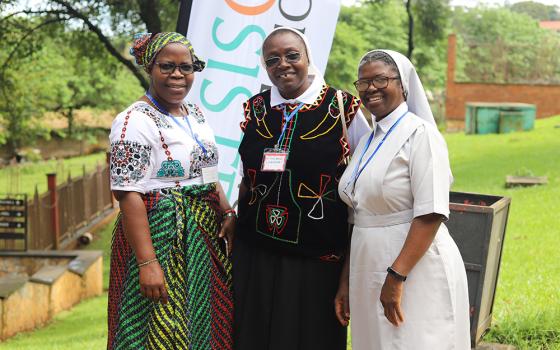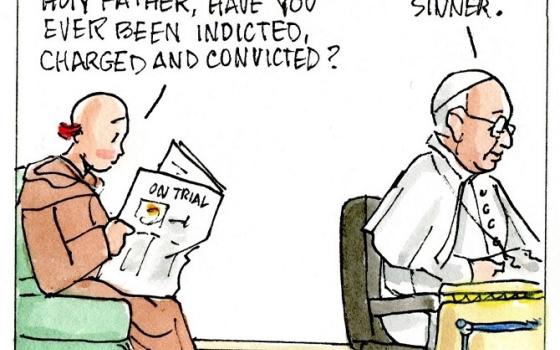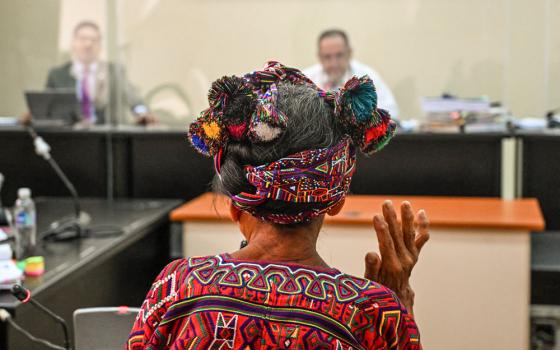A contingent of business leaders, health care professionals, academics and environmental activists from around the country gathered here at the University of Dayton in early November to delve into the concept of divestment from fossil fuels.
The conference, titled “Acting on Pope Francis’ Call: Divestment and Investment in Care for Our Common Home,” ran Thursday through Saturday at Dayton’s Hanley Sustainability Institute. Speakers included Stephen Colecchi, director of the U.S. bishops’ conference Office of International Justice and Peace; Dayton president Daniel Curran; and numerous representatives from the investment sector.
Dayton offered a fitting setting for such a discussion, as the Marianist school a year ago became the first U.S. Catholic educational institution to initiate the process of moving its $670 million endowment away from fossil fuel investments.
A primary focus of the conference centered on the means and methods for organizations to turn their beliefs about carbon-producing energies into actionable steps toward divesting to some degree their endowments from fossil fuels.
The first session Friday morning focused on the arguments for divestment, such as the economic benefits and Catholic moral grounds for such action. This acted as background to examples introduced by the speakers, who focused on the approaches and effectiveness of previous strategies.
The Rev. Fletcher Harper, executive director of Greenfaith, viewed the oil industry as embracing the role of “the bad guy,” and found the effectiveness of previously attempted methods to affect change in the industry severely lacking. The Episcopal priest based that assessment on the fact that the oil industry is still spending billions each day searching for oil. Fletcher -- whose interfaith organization provides extensive divestment resources and has hosted numerous webinars on the topic for religious communities -- argued against the shareholder activism approach, saying it has not, nor will, have a large enough impact to alter drastically their core business models.
A question posed to the panel asked about the possibility of a middle ground approach, where an organization maintains enough shares to have a “seat at the table” while satisfying their ecological and moral commitments. Responses from the panel were mixed, although they agreed that anything was better than nothing, and that each organization should follow its own faith path.
The lack of change in the oil industry is a large reason for the current strategic shift toward divestment, as it better follows the morality of the investing institutions. At the same time, several speakers said it makes sense as an economic decision, as well.
“The largest carriage makers of the 19th century did not become the largest auto makers of the 20th,” Harper said when asked his thoughts on rigidness of traditional fuel companies toward changes in their industry.
More: "Loyola-Chicago climate conference discusses 'nuts and bolts' of fossil fuel divestment" (March 25, 2015)
From there, the conference -- a majority of its attendees favoring divestment in some fashion -- shifted from the arguments for divesting into questions of what it should look like. Two distinct questions arose: How much to divest? And where to reinvest?
Plans for divestment stretched along a wide variety of options: on one end, partial industry divestment, and on the other, complete end-to-end divestment that included abandoning the most fossil fuel heavy industries, such as the biggest energy expenders of the shipping and chemical production industries.
As for where to redirect endowment funds, some speakers advocated for renewable technology and energy storage. The strategy, they said, deals a double-blow for environmentally minded investors, by lowering stock values of fossil fuel industries while raising them for their green counterparts.
Sr. Maureen Fiedler, whose Loretto Community earlier this summer opted for divestment, advocated this strategy as a way to keep money invested in the energy sector but in a way that matches the moral character of the institutions. A general consensus arose at the conference for the use of “social” stock indices, such as the Domini 400, that prioritize socially responsible investing. Often, investments in socially and ecologically responsible companies, they said, can match the market average investment yield.
Tom Van Dyck, a senior vice president in financial advising with RBC Wealth Management, praised the expected growth for sustainable energy sectors and their accompanying economic gain. He also suggested renewables offer greater stability as investments today than oil and gas.
One of the economic reasons for the stability is the possibility for long-term energy savings by signing significant year-over-year deals, in which energy companies sell renewable energy. Van Dyck, who consulted the University of Dayton on its road to divestment, mentioned that major electrical users, such as Google and Wal-Mart, have begun to negotiate such deals. Due to their prices being relatively unaffected by a commodities market, these companies offer energy deals with prices established for years, taking the traditional volatility of the energy market out of the equation.
Another suggestion for reallocating divested funds came from Mark Orlowski, founder of the Sustainable Endowments Institute. The institute’s Green Revolving Investment Tracking System (GRITS) is designed specifically with endowment investment portfolios in mind, he said, with the goal to take funds out of the fossil fuel industries, and invest them in green initiatives around campuses and their neighboring communities. The system then calculates the annual carbon and financial savings of each of the institution’s invested projects, the value of which is then placed into a fund for the continued advancement of future eco-friendly projects in the community.
Such an approach allows the institutions using GRITS to expand and easily track the budget for green projects on a yearly and project basis, Orlowski said. The general hope is to veer the divested funds as far away from the fossil fuel industries as possible by placing them in local green initiatives. A continued energy stock portfolio sans fossil fuels could accompany the green projects investment as a way to use a stock investment as a statement of institutional morality and purpose.
Another method discussed at the conference, put forth by Liz Michaels, director of socially responsible investing for the Aperio Group, seeks to shift stocks in an endowment’s investing portfolio away from the fossil fuel industry in each sector of the economy. This would involve awareness of the worst emissions offenders, along with their supply chains, in each industry, and a concerted effort to steer portfolios clear of them. In this capacity, the Domini Index or similar company rankings could replace traditional indices like the S&P 500, depending on the degree an organization wishes to tilt its funds from fossil fuels.
[Leo J. Schenk is a staff writer for the Dayton University student newspaper, the Flyer News.]
Editor's Note: Want more stories from Eco Catholic? We can send you an email alert once a week with the latest. Just go to this page and follow directions: Email alert sign-up.



